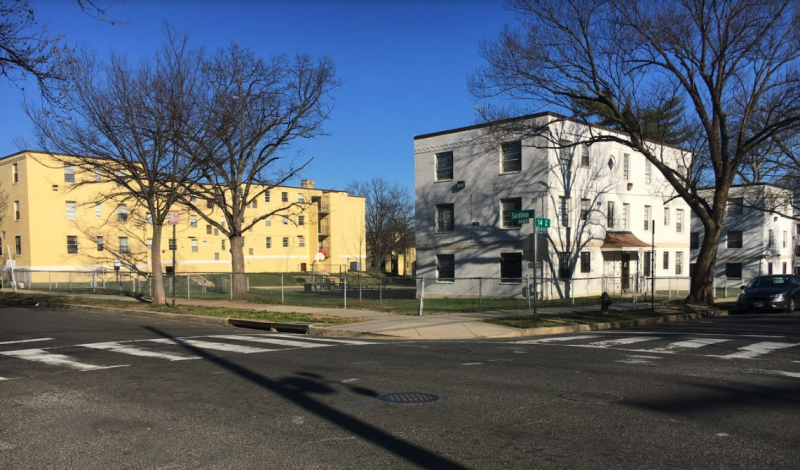Brookland Manor: A crash course in why housing in DC is so complicated

Brookland Manor. Image by the author.
Just east of the the Rhode Island Avenue Metro, there’s a gigantic housing complex called Brookland Manor. The owners plan to redevelop it and say they’re building far more affordable housing than DC law requires. The people who live there now say the owners aren’t coming close to meeting the area’s need for affordable housing. They’re both right.
It’s a contentious case that weaves together just about every detail related to housing and development in DC that you can think of. And it’s going to be debated in hearings for years to come.
Redevelopment is coming to Brookland Manor
Brookland Manor is a 20 acre, 19 building housing complex at the corner of Rhode Island Avenue and 14th Street NE. 373 of the units have a contract where the federal Department of Housing and Urban Development pays the rent above one-third of each tenant’s income.
MidCity Financial Corporation, the complex’s owner, has nearly paid off its federally subsidized mortgage. Once payment is complete in August, the HUD contracts will also expire and MidCity will be free to redevelop the property. Currently, MidCity plans to tear down the existing buildings and build 1,760 new units. 373 would remain under contract with HUD, and the remainder would rent at market rate.
MidCity says it will let most of the current residents come back once the new buildings are finished, though some tenants and affordable housing advocates doubt that will actually come to pass.
Why MidCity says its plan is great
Legally, MidCity does not have to keep 373 units under HUD contract. In fact, DC law says MidCity only has to build 165 moderately-affordable units, and that it could have zero HUD contract units. But MidCity wants to build more affordable housing than the legal minimum for two reasons. First, the company prides itself on a history of building affordable housing, and representatives say they want to keep that in the company’s mission.
Second, by building this amount of affordable housing, it may get to build larger buildings overall under a process known as a Planned Unit Development.
Why tenants and advocates say the plan is bad
Tenants and advocates are currently unhappy with MidCity’s proposal for two main reasons.
First, they don’t think the plan includes enough affordable housing, especially when you consider that beyond those living in HUD-subsidized units, most other Brookland Manor residents are receiving some kind of government assistance.
MidCity says it is providing double what is legally required. That’s true, legally. But tenants and advocates say that the legal affordable housing requirement is too low. They say MidCity has a greater responsibility to the government and low-income renters because the company received government-subsidized rents and because it got a low-interest mortgage on Brookland Manor from the feds. So they’re asking the District government to push MidCity to provide more affordable housing than the current legal minimum.
Second, tenants and advocates think MidCity is being a bad actor, working to either push tenants out before redevelopment (so the company wouldn’t be obligated to let them move into the new buildings) or otherwise make those who don’t move out ineligible to live in the new building.
It didn’t have to be this way
MidCity initially wanted to build something a lot bigger, with a lot more affordable housing. The DC Office of Planning and the Zoning Commission said they liked the project, but that the Comprehensive Plan, which governs land use, didn’t allow buildings that big.
So here we are, with MidCity and tenants fighting over a smaller supply of affordable homes because the Comp Plan limits building.
We’ll go into the details in upcoming posts
This story is complicated. Really complicated. But it’s also important, not just because it’s a contentious case that will be with for us years, but also because if you understand a bit about what’s going on Brookland Manor, you’re going to understand a lot about the world and politics of building housing in fast-growing Washington, DC.
While these details are particular to Brookland Manor and the people, places, and organizations involved there, the fundamental tensions and questions involved are universal to developments across the District. How much affordable housing is the right amount? Who should build it, and with what money? Who’s responsible for making sure we have enough affordable housing? What counts as affordable housing, and who is it for?
In the coming days, we’re going to dig into the events at Brookland Manor via a series of posts by Pete Rodrigue, a GGWash super volunteer. Pete has poured countless hours of his own time into understanding the ins and outs of what’s happening at Brookland Manor, and we’re very excited to share his excellent work with you.
Here's Pete's complete series of posts:
- Brookland Manor: What’s there now, what the owners want to build, and what that could mean for affordable housing
- How the DC government shot itself in the foot at Brookland Manor
- Would plans for Brookland Manor mean fewer affordable apartments? Yes, if you look closely.
- “We’re already in jail:” Evictions and private policing at Brookland Manor
- Redevelopment at Brookland Manor moves forward, but affordable housing challenges loom
